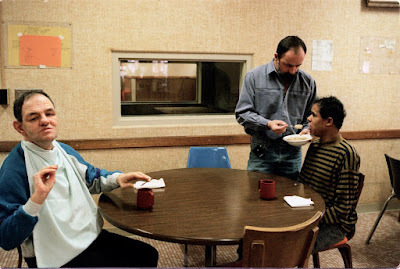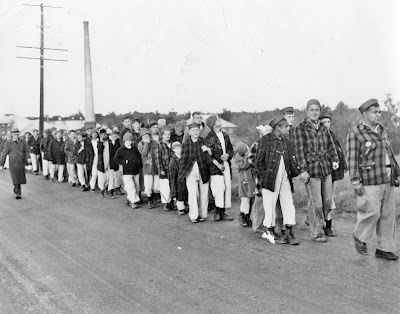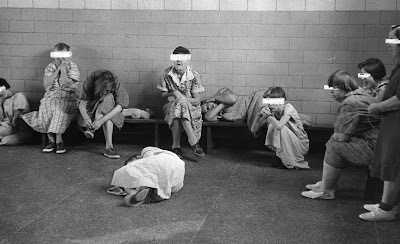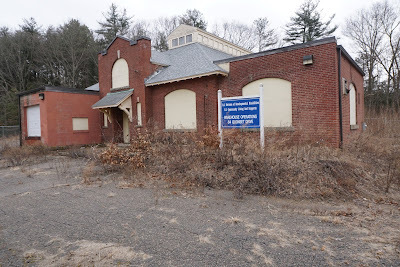The Ladd Center, 25 years after it closed.
Originally published in The Providence Journal, when I was a staff writer.
EXETER — The last lunch had ended when five residents of the Ladd Center,the state’s lone institution for people with developmental and intellectualdisabilities, were escorted into a van. The driver took them off into thebrightness of a pleasant spring day.
It was March 25, 1994.
After nine decades that began with compassion but included years of theworst neglect and abuse ever for many of Rhode Island’s most vulnerableresidents, Ladd was closed.
“The beast is dead,” said Robert L. Carl Jr., the administrator whoplayed a leading role in making Rhode Island the first state to shutter such aplace. “Nazi Germany killed these people. Rhode Island made a commitment totreat them with dignity and respect. Nobody will ever be able to throw away ahuman being again.”
A community system years in planning had brought people then described as“retarded” out of back wards in buildings that resembled warehouses into theeveryday world that most Rhode Islanders inhabited. Into the light, too, hadcome other individuals from private residences where families struggled withcare and suffocated under the crush of stigma and shame.
The beast really was dead, Carl recalled when The Journal visited him athis Jamestown home recently. A new day really had dawned.
“Nobody had ever set up a policy that said, ‘We're not going toinstitutionalize; we're going to take care of everybody in the community,’”Carl said. “Nobody. Nobody had ever tried to do that in the country, in theworld.”

Withthe aid of an attendant, two of the last five residents of the Ladd Center,Raymond Guarnieri, left, and Anthony Stanton, eat before leaving for a grouphome on March 25, 1994, the day Ladd closed its doors. [The Providence Journal,file / Kathy Borchers]
Ironically, in light of what would follow, humane care was the philosophybehind the General Assembly’s 1907 decision to establish a safe place forindividuals deemed unable to care for themselves. At the time, many had beenlocked away in attics or basements, or were homeless, or incarcerated at thestate poorhouse at the Howard complex in Cranston, where Eleanor SlaterHospital and the Adult Correctional Institutions stand today. There, they werefurther victimized.
“For a long time it had been apparent to educators and officials of theState, the conduct of whose offices brought them into contact with thedefective, dependent and delinquent classes, that there was a great need of aninstitution in Rhode Island where boys and girls, or even young men and youngwomen, who were classed under the general head of ‘feeble-minded’ could becared for, properly trained and instructed, and in the end made as far aspossible self-supporting …” The Journalwrote on Feb. 2, 1908, the day after Ladd opened.
Set in one building on the Hoxsie Farm, which had acres of land forfuture expansion, the center was called the state School for the Feeble-Minded.Its first superintendent was the young Dr. Joseph H. Ladd, who came to RhodeIsland from Massachusetts.
The Ladd School, as it was later renamed, did provide sanctuary, for atime. It also served an ugly, if not officially proclaimed, purpose: itprevented its residents from marrying and having children, in accord with thenational eugenics movement, which supported laws and policies aimed atpreventing people judged “inferior” from reproducing, a policy implemented byHitler. In other states, developmentally disabled women were forciblysterilized, but Rhode Island had no such law and there is no confirmed recordof it happening, according to Universityof Vermont Prof. Lutz Kaelber, a scholar who has researched eugenics and Nazi killings of disabledchildren.
By the 1950s, Ladd’s turn-of-the-century promise of safety and care haddevolved into purgatory — almost literally, as a shocking photo exposé woulddemonstrate.

Residentsof what was then known as the Exeter School go on a walk for exercise in 1941.[The Providence Journal, files]

Ladd Center residents in 1977. Deplorable conditions in the 1970s at thestate-run facility prompted legal action and advocacy that eventually led toits closure. [The Providence Journal, files]
By 1956, when The Journal published the first investigation of deplorableconditions at Ladd, the old Hoxsie Farm was a sprawling complex of overcrowdedred-brick buildings where lives had been swallowed, its residents’ identitiesoften erased. Tangible evidence of that can be found at Ladd’s forgottencemetery, where small tombstones contain only serial numbers, no names or datesof birth or death. So, too, atthe potter’s field for the nameless deceased from another now-closed Rhode Islandinstitution for the mentally ill, the Institute of Mental Health.
In their March 1956 investigation, “The ForgottenTwo Per Cent,” Journal writers Selig Greenberg and George F. Troy Jr. chronicledhorrors that could be traced to the early days of Ladd, when its firstsuperintendent lobbied the General Assembly for increased financial resources —and was met with legislative disinterest, and worse.
“Dr. Ladd recalls that when he appeared before a state budget committeein 1913 to request an appropriation for teachers, he was told bluntly that‘instead of teachers there should be established an asphyxiation chamber’ atExeter School,” Greenberg wrote. Nazi Germany, as Carl later noted, didestablish them for the developmentally disabled.
Ladd returned to Exeter after his 1913 State House appearance, TheJournal wrote, “for a long and lonely siege of waiting and wrestling withinertia and neglect.”
Some progress eventually was made, but by 1956, during an era when Ladd’spopulation peaked at more than 1,000, The Journal found that “the legacy ofgross neglect in the past and continued skimping on appropriations” had createda situation involving “the anguish of blighted lives, of the failure to salvagehuman material that is not beyond saving — a failure for which no dollar andcent yardstick can ever be devised.”
Remedial efforts led to improvements, but by the late 1970s, Ladd wasstill more warehouse than home. In the wake of scandals in many states and thelandmark 1966 exposé by Burton Blatt, “Christmas in Purgatory,” which includedphotographs of abused and neglected Ladd residents, a consensus was emergingacross the U.S. that institutions had to be closed. Publication in 1972 of WolfWolfensberger’s revolutionary “The Principle of Normalization in HumanServices” also proved instrumental.
Onto the local scene came James V. Healey, an advocate behind a 1978federal class-action human-rights lawsuit against the state; Laddsuperintendent George W. Gunther Jr., father of a woman who lived at thecenter; and Carl. Gunther and Carl worked for the Department of Mental Health,Retardation and Hospitals (now the Department of Behavioral Healthcare,Developmental Disabilities and Hospitals), headed by Joseph J. Bevilacqua andhis successor, Thomas D. Romeo.
The first steps in building a community system were taken, with thesupport of Gov. J. Joseph Garrahy and the General Assembly, where Rep.Paul V. Sherlock championed people with developmental disabilities. Time andagain, voters approved bond issues to build community homes and programs.
The movement received a significant boost with publication of “The LaddSchool,” a 1977 Journal series by staff writers Peter Perl, Bruce DeSilva and Thomas E.Walsh. The seriesdocumented “serious deficiencies in medical and dental services, inadequatestaffing and poor training, overcrowding in some wards within the institution,improper medication, poor sanitation and physical plant,” among otherconditions. Some buildings were deemed fire traps.
“A Ladd School physician has been fired for allegedly stitching wounds oftwo medical patients without using an anesthetic,” was but one result of theinvestigation.
Convinced that the very existence of Ladd was intolerable, Gov. EdwardDiPrete, who followed Garrahy in office, announced in 1986 that the institutionwould close.
The beast is dead — but the model community system of the 1990s thatreplaced Ladd is inadequate a quarter of a century later, as a Journalinvestigation three years ago documented. Joseph Ladd’s “waiting and wrestling with inertia andneglect” are words that ring true today, albeit within a different context.
Anthony A. Antosh, director of Rhode Island College’s Paul V. SherlockCenter on Disabilities, and state Sen. Louis DiPalma, a champion for peoplewith developmental and intellectual disabilities who describes his ambition asbeing “a voice for the voiceless,” are among those leading the campaign forchange.
Both praise Behavioral Healthcare, Developmental Disabilities andHospitals Director Rebecca Boss and her staff for their efforts in addressingthe 2014 federal Department of Justice consent decree requiring Rhode Island tomore thoroughly integrate individuals into the community and away from thepost-Ladd model of sheltered workshops and other isolated settings. But bothassert that the system remains underfunded and stuck in policies and aphilosophy from an earlier century.
Antosh supports moving away from old-fashioned “person-centered planning”toward “person-centered thinking,” which he defines as ways toallow people with developmental or intellectual disabilities to have the samechoices and chances that anyone has. One’s life is not fulfilled when onlyemployment and housing needs are met, Antosh says.
He summarizes the new approach as “three big concepts.”
First, he said, is, “The person ought to be much more in charge of theirown life than they now are.
“Two, think about all of life, not just work,” he said. Entertainment,recreation and relationships fit that category.
“Three, because there's so much of life that should be spent in thecommunity doing all of those things, we need to think about how we engage thecommunity in a very different way than we currently do," Antosh said.

A decaying building is one of the few remnantsof the Ladd Center, in Exeter, which formerly housed Rhode Islanders withdevelopmental and intellectual disabilities. [The Providence Journal / SandorBodo]
A key to getting there, says DiPalma, is work by the General Assembly’sProject Sustainability Commission, which he chairs. Antosh belongs, as do Boss,state Medicaid director Patrick Tigue, and other government and privateofficials involved with the developmentally disabled.
“The system at a macro level needs to radically change from what we'redoing today,” DiPalma says. “We can't look at this from the perspective ofpruning the tree.”
“In the institution days, the institution was totally in control of everyminute of a person’s life,” Antosh says. “As we have gravitated toward morecommunity services, the service provider is still largely in control of majorportions of the person’s life. The revolution to me is to put the person andtheir family or their immediate contacts — whoever are their primary people intheir lives — more in control.”
Jimmy Isom, who was born in Cranston in 1946, was sent to Ladd at the ageof 6. He stayed 22 years. Retired now and living in an apartment in NorthProvidence, he enjoyed a long career working for Stop & Shop and othergrocers after leaving Ladd.
“I thought I’d never get out,” he recalled of his decades in Exeter in arecent interview. “It was no good. It was like getting locked up, almost like aprison.”
Isom is one of the former Ladd residents who is featured in the upcomingdocumentary “Best Judgment: Ladd School Lessons,” directed by filmmaker JimWolpaw.
“I’m glad I got out of Ladd School,” he says. “I don’t want to go back.”
Some People Who Lived at the LaddCenter... from Advocatesin Action RI on Vimeo.
A resident in her room at the Ladd Center in 1977. [The ProvidenceJournal / Anestis Diakopoulos]
One 'beast' slain, but barriers remain for those withdisabilities
After bearing witness tothe Ladd Center's final years, writer G. Wayne Miller reflects on how treatmenthas evolved for those living with mental and developmental disabilities.
BY G. WAYNE MILLER
EXETER — It is rare to have a front-row seat to history, but I had one 25years ago Monday, when the last residents left the Ladd Center and it closedfor good. Rhode Island was the first state to no longer have a publicinstitution for the developmentally and intellectually disabled, and watchingthose five men ride off to a better life gave us the chills.
“Us” was me; the late James V. Healey, an advocate who never accepted nofor an answer; George W. Gunther Jr., father of a daughter with special needswho became Ladd superintendent vowing to one day shutter the place; and RobertL. Carl Jr., the colorful state official whose nickname, “Wolfman,” ostensiblywas for his resemblance to the legendary DJ but really spoke to an almostsupernatural ability to get things done. Good things, in Carl’s case.
When the van carrying the final five had disappeared into the real world— never again to be chained to their beds, have their teeth drilled withoutanesthetic, or be hosed down naked en masse in what purportedly constitutedbathing — we gathered in Gunther’s office.
“The beast is dead,” Carl said.
I can still hear him — still remember the look on his face, a mix ofelation and fatigue — for the road to March 25, 1994, had been long and hard.In my four decades as a journalist, those four words remain my favorite quote.
Together with the efforts of Carl, Healey, Gunther and many others,Providence Journal exposés of Ladd’s barbarism starting in the 1950s had playeda role in killing the beast. Thanks to retired Journal editor Joel P. Rawson,who assigned me to a beat that also included the now-closed state Institute ofMental Health, another place of shame, I had covered Ladd since 1983.
By then, the age of abuse was ending.
But I had come to know that story well, from newspaper clippings andlawsuits and many hours spent with Healey and the boss of Gunther and Carl:Thomas D. Romeo, director of the state Department of Mental Health, Retardationand Hospitals, now the state Department of Behavioral Healthcare, DevelopmentalDisabilities and Hospitals.
And also, of course, the hundreds of hours I spent getting to know Laddpeople and former residents who had moved into the community.
My first experiences came during the year-long reporting behind mysix-part series “Building newlives: A revolution in care — How Rhode Island became a leader in movingmentally ill, retarded out of state hospitals and back into the real world,” which began on Nov.25, 1984.
Many morestories followed as the Ladd population dwindled and the community system grew. In1990, four years after Gov. Edward DiPrete had announced that Ladd would close,I lived for a week in one of Ladd’s remaining residences to write the July 19,1990, piece “Lorraine'sworld: As Ladd Center prepares to close, a new day dawns for the profoundlydisabled.”
Similarly, as residentsof the IMH in Cranston — another place of long-standing abuse and neglect — left for thecommunity, I was allowed to live a week there for a Journal story.
Mental-health and developmental-disability writing had become myjournalistic passions; they remain so today. And while one beast is dead, alook around reveals that other beasts are very much alive.
If only Ladd and the IMH had served as true cautionary tales.



